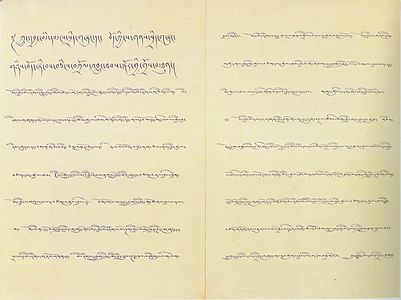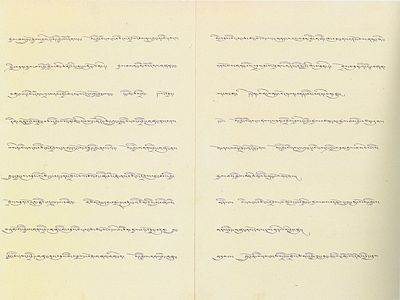Agreement for the Peaceful Liberation of Tibet
| Tibetan name |
|---|
|
Tibetan script :
ཀྲུང་ དབྱང་ མི་ དམངས་ སྲིད་གཞུང་ དང་ བོད་ ཀྱི་ ས་གནས་ སྲིད་གཞུང་ གཉིས་
བོད་ ཞི་ བས་ བཅིངས་ བཀྲོལ་ འབྱུང་ ཐབས་ ཐབས་ སྐོར་ གྱི་ གྲོས་ མཐུན ། |
|
Wylie transliteration : krung dbyang mi dmangs srid gzhung dang bod kyi sa gnas srid gzhung gnyis bod zhi bas bcings bkrol 'byung thabs skor gyi gros mthun
|
|
Pronunciation in IPA : [
ʈʂúŋjaŋ mìmaŋ síɕuŋ tʰàŋ pʰø̂ːgi sánɛ̂ːˀ síɕuŋ ɲîːˀ pʰø̂ːˀ ɕìwɛˀ tɕíŋʈʂøː tɕùŋtʰəpkɔːki ʈʂʰø̂ːtỹ ]
|
|
Official transcription of the PRCh : Zhungyang mimang sixung tang Poigi sanai sixung nyi Phoi xiwai jingzhoi jungtabgorgi choidün
|
|
THDL transcription : Trungyang mimang sizhung dang Bögi sané sizhung nyi Bö zhiwa chingtröl jungtapkorgi trötün
|
| Chinese name |
|
Traditional :
中央 人民政府 和 西藏 地方政府 關於 和平 解放 西藏 辦法 的 協議
|
|
Simplified :
中央 人民政府 和 西藏 地方政府 关于 和平 解放 西藏 办法 的 协议
|
|
Pinyin : Zhōngyāng rénmín zhèngfǔ hé Xīzàng dìfāng zhèngfǔ guānyú hépíng jiěfàng Xīzàng bànfǎ de xiéyì
|
The 17-point agreement for the peaceful liberation of Tibet (officially agreement between the Central People's Government and the Local Government of Tibet on measures for the peaceful liberation of Tibet ) is an agreement signed in Beijing on May 23, 1951 between the People's Republic of China and Tibet . The signatories were representatives of the Central People's Government and the Tibetan Government. On October 24, 1951, the 14th Dalai Lama Tendzin Gyatsho telegraphed his approval to Mao Zedong and the government in Beijing, following a resolution by the Tibetan National Assembly in Lhasa .
The content of the agreement is the assumption of territorial sovereignty over Tibet by the People's Republic of China, the assurance of internal political autonomy and religious freedom of Tibet by the PRC, and at the same time the foreign policy representation of Tibet by the PRC.
According to Article 52 of the Vienna Convention on the Law of Treaties of May 23, 1969, to which the People's Republic of China also acceded, contracts signed under the threat or use of force are null and void. However, the convention only applies to treaties concluded by states after their accession. The applicability of the convention to the 17-point agreement is therefore controversial according to the legal principle Pacta tertiis nec nocent nec prosunt (“Contracts neither harm nor benefit third parties”). The extent to which there is a violation of customary international law is questionable.
View of the Tibetan government in exile
From the perspective of the Tibetan government in exile , the agreement came about under military pressure as a result of the occupation of the eastern Tibetan province of Qamdo and under threat of further military advance by the Chinese People's Liberation Army . The Dalai Lama , then 16-year-old Tendzin Gyatsho , later declared in exile that he had agreed to the agreement in order to “save his people and the country from total destruction”.
Contract text
Seventeen points
- The Tibetan people will unite and expel the imperialist aggressive forces from Tibet; the Tibetan people will return to the bosom of the great family of the People's Republic of China.
- The local government of Tibet will actively assist the People's Liberation Army in reaching Tibet and consolidating national defenses.
- According to the nationality policy recognized in the joint program of the Chinese People's Political Consultative Conference , the Tibetan people have the right to exercise national territorial autonomy under the unified leadership of the Chinese People's Government.
- The central authorities will not change the existing political system in Tibet. Nor will the central authorities change the existing status, functions and powers of the Dalai Lama. The officials of the various ranks remain in office as usual.
- The existing status, functions and powers of the Panchen Ngoerhtehni are to be retained.
- The existing status, offices and powers of the Dalai Lama and Panchen Ngoerhtehni refer to the status, offices and powers of the 13th Dalai Lama and the 9th Panchen Ngoerhtehni when they had friendly and trusting relationships with one another.
- The policy of religious freedom of belief is determined according to the joint program of the Chinese People's Political Consultative Conference. The religious beliefs, customs and habits of the Tibetan people will be preserved and lama monasteries will be protected. The central authorities will not change the income of the monasteries.
- Tibetan troops are gradually being integrated into the People's Liberation Army and becoming part of the armed forces of the PRC.
- The spoken and written language and the educational system of the Tibetan nationality will be developed step by step in accordance with the existing conditions in Tibet.
- Tibetan agriculture, animal husbandry, industry and trade will be developed step by step, and people's livelihoods will be improved step by step in accordance with the existing conditions in Tibet.
- There will be no coercion from the central authorities regarding various reforms in Tibet. The local government of Tibet will undertake reforms of its own accord and if the people demand reforms, they will be initiated through consultation with the Tibetan leaders.
- To the extent that formerly pro-imperialist and pro- Kuomintang -minded officials severely break ties with imperialism and the Kuomintang and do not engage in sabotage or resistance against China, they can continue to hold office regardless of their past.
- The People's Liberation Army forces relocated to Tibet will honor all of the above agreements and be fair in all their purchases and sales, and will not arbitrarily steal a needle or thread from the people.
- The Chinese People's Government will carry out all foreign policy tasks for the Tibet Territory; and there will be peaceful coexistence with neighboring countries and the establishment and development of fair business and trade relations with them on the basis of equality, mutual benefit and mutual respect for borders and sovereignty.
- To ensure the implementation of this agreement, the Chinese People's Government is establishing a Military and Administrative Committee and Military District Headquarters in Tibet, and will involve local Tibetan personnel as much as possible, regardless of the personnel deployed by the Chinese People's Government. These Tibetan personnel who participate in the Military and Administrative Committee may include patriotic elements from the local government of Tibet, from various counties, and from various major monasteries; the list of names will be confirmed after consultation between the representatives of the Chinese People's Government and the various sides and will be submitted to the Chinese People's Government for the nomination of the chosen ones.
- Costs incurred by the Military and Administrative Committee, Military District Headquarters, and People's Liberation Army troops relocated to Tibet will be borne by the Chinese People's Government. The local government of Tibet should assist the People's Liberation Army in buying and transporting food, fodder and other daily necessities.
- This agreement will come into effect immediately after it has been signed and sealed.
Signed and sealed by the delegates of the Chinese People's Government:
- Delegation leader: Li Wei-han (Head of the Interior Commission);
- Delegates: Chang Ching-wu, Chang Kuo-hua, Sun Chih-yuan
Delegates from the local government of Tibet:
- Delegation leader: Kaloon Ngabou Ngawang Jigme (Ngabo Shape);
- Delegates: Dzasak Khemey Sonam Wangdi, Khentrung Thuptan, Tenthar, Khenchung Thuptan Lekmuun Rimshi, Samposey Tenzin Thondup
Images of the contract (Chinese)
Images of the contract (Tibetan)
literature
- བོད་ རང་སྐྱོང་ ལྗོངས་ ལོ་རྒྱུས་ ཡིག་ ཚགས་ ཁང ། (Ed.): བོད་ ཀྱི་ ལོ་རྒྱུས་ ཡིག་ ཚགས་ གཅེས་ བསྡུས ། Beijing, རིག་ དངོས་ དཔེ་ སྐྲུན་ ཁང ། 1995, ISBN 7-5010-0876-0 / ISBN 7-5010-0879-5 . Contains a facsimile of the original text in Tibetan and Chinese and an English translation.
- Press Office of the State Council of the People's Republic of China (Ed.): 50 Years of Democratic Reforms in Tibet . Peking, Publishing House for Foreign Language Literature, 2009, ISBN 978-7-119-05638-8 .
Footnotes
- ^ Tsering Shakya : The genesis of the Sino-Tibetan agreement of 1951 . In: Alex McKay: The History of Tibet - The Modern Period: 1895-1959. The Encounter with Modernity. Routledge 2003, ISBN 0-415-30844-5 , p. 603; A. Tom Grunfeld: The Making of Modern Tibet. ME Sharpe 1996, ISBN 1-56324-714-3 , p. 113; Stephan Haas : The Tibet question - an analysis of the reasons and the legality of the Chinese invasion of Tibet in 1950/1951. LIT Verlag , 1997, ISBN 3-8258-2872-7 ; བོད་ རང་སྐྱོང་ ལྗོངས་ ལོ་རྒྱུས་ ཡིག་ ཚགས་ ཁང ། (Ed.): བོད་ ཀྱི་ ལོ་རྒྱུས་ ཡིག་ ཚགས་ གཅེས་ བསྡུས ། Beijing, རིག་ དངོས་ དཔེ་ སྐྲུན་ ཁང ། 1995, ISBN 7-5010-0876-0 / ISBN 7-5010-0879-5 , document 101; Answer by Mao Zedong: Document 102.
- ↑ Facts About The 17-Point "Agreement" Between Tibet and China (PDF; 2.9 MB), Part One: "The 17-Point Agreement" - The full story as revealed by the Tibetans and Chinese who were involved. DIIR Publications 2001
- ↑ Seventeen-Point Plan for the Peaceful Liberation of Tibet (1951), p. 182, May 29, 1951 Tibet Justice Center publications. Oakland, USA
Web links
- A translation of the full text including preamble of the agreement , tibetjustice.org
- A translation of the full text including preamble of the agreement , china.org.cn
- Facts About The 17-Point "Agreement" Between Tibet and China (PDF; 2.9 MB). DIIR Publications 2001
- The Chinese View of the Seventeen Point Agreement - China Tibet Information Center ( Memento of September 30, 2007 in the Internet Archive ), zt.tibet.cn

















